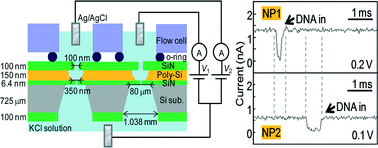Multichannel detection of ionic currents through two nanopores fabricated on integrated Si3N4 membranes†
Abstract
Integration of solid-state nanopores and multichannel detection of signals from each nanopore are effective measures for realizing high-throughput nanopore sensors. In the present study, we demonstrated fabrication of Si3N4 membrane arrays and the simultaneous measurement of ionic currents through two nanopores formed in two adjacent membranes. Membranes with thicknesses as low as 6.4 nm and small nanopores with diameters of less than 2 nm could be fabricated using the poly-Si sacrificial-layer process and multilevel pulse-voltage injection. Using the fabricated nanopore membranes, we successfully achieved simultaneous detection of clear ionic-current blockades when single-stranded short homopolymers (poly(dA)60) passed through two nanopores. In addition, we investigated the signal crosstalk and leakage current among separated chambers. When two nanopores were isolated on the front surface of the membrane, there was no signal crosstalk or leakage current between the chambers. However, when two nanopores were isolated on the backside of the Si substrate, signal crosstalk and leakage current were observed owing to high-capacitance coupling between the chambers and electrolysis of water on the surface of the Si substrate. The signal crosstalk and leakage current could be suppressed by oxidizing the exposed Si surface in the membrane chip. Finally, the observed ionic-current blockade when poly(dA)60 passed through the nanopore in the oxidized chip was approximately half of that observed in the non-oxidized chip.


 Please wait while we load your content...
Please wait while we load your content...